Volume 7, Issue 3 (6-2020)
jbrms 2020, 7(3): 36-46 |
Back to browse issues page
Download citation:
BibTeX | RIS | EndNote | Medlars | ProCite | Reference Manager | RefWorks
Send citation to:



BibTeX | RIS | EndNote | Medlars | ProCite | Reference Manager | RefWorks
Send citation to:
Shanbehzadeh M, Basati G, Kazemi-arpanahi H. Determining a suitable technical architecture for COVID-19 information exchange infrastructure: A case for Iran. jbrms 2020; 7 (3) :36-46
URL: http://jbrms.medilam.ac.ir/article-1-511-en.html
URL: http://jbrms.medilam.ac.ir/article-1-511-en.html
Department of Health Information Technology, Abadan Faculty of Medical Sciences, Abadan, Iran , hadi.kazemi67@yahoo.com
Abstract: (3214 Views)
Introduction: Improving the quality, safety and effectiveness of health care services is the most important advantages of using the Public Health Information Exchange (PHIE) infrastructure. This infrastructure has three centralized, decentralized, and hybrid architectures. This study sought to identify the most appropriate technical architecture for the coronavirus disease (COVID-19) Information Exchange (CoVIE) based expert panels.
Materials and methods: In order to identify the desired CoVIE technical architecture, a qualitative approach was used and a number of meetings were held with experts in Health Information Technology and Management (HITM) and Health Informatics fields working at Iran, Tehran and Shahid Beheshti University of Medical Sciences (IUMS, TUMS and SBUMS). Basic concepts, including the type of technical architecture and exchange context, were categorized and discussed in terms of themes, sub-themes, and codes. Finally, the results were evaluated using content analysis and descriptive statistics.
Results: The universities of Iran and Tehran had chosen hybrid model in national context and Shahid Beheshti University selected regional centralized model as the optimal technical architecture for CoVIE.
Conclusion: Hybrid model with implementation at national context was selected for CoVIE in Iranian health system. Implementation of this architecture improves the effective management of information exchange in the context of CoVIE.
Materials and methods: In order to identify the desired CoVIE technical architecture, a qualitative approach was used and a number of meetings were held with experts in Health Information Technology and Management (HITM) and Health Informatics fields working at Iran, Tehran and Shahid Beheshti University of Medical Sciences (IUMS, TUMS and SBUMS). Basic concepts, including the type of technical architecture and exchange context, were categorized and discussed in terms of themes, sub-themes, and codes. Finally, the results were evaluated using content analysis and descriptive statistics.
Results: The universities of Iran and Tehran had chosen hybrid model in national context and Shahid Beheshti University selected regional centralized model as the optimal technical architecture for CoVIE.
Conclusion: Hybrid model with implementation at national context was selected for CoVIE in Iranian health system. Implementation of this architecture improves the effective management of information exchange in the context of CoVIE.
Keywords: COVID-19, Public Health Information Exchange (PHIE), Technical architecture, Hybrid model, Centralized model, Decentralized model
Type of Study: Research |
Received: 2020/03/8 | Accepted: 2020/06/24 | Published: 2020/06/1
Received: 2020/03/8 | Accepted: 2020/06/24 | Published: 2020/06/1
Send email to the article author
| Rights and permissions | |
 |
This work is licensed under a Creative Commons Attribution-NonCommercial 4.0 International License. |





